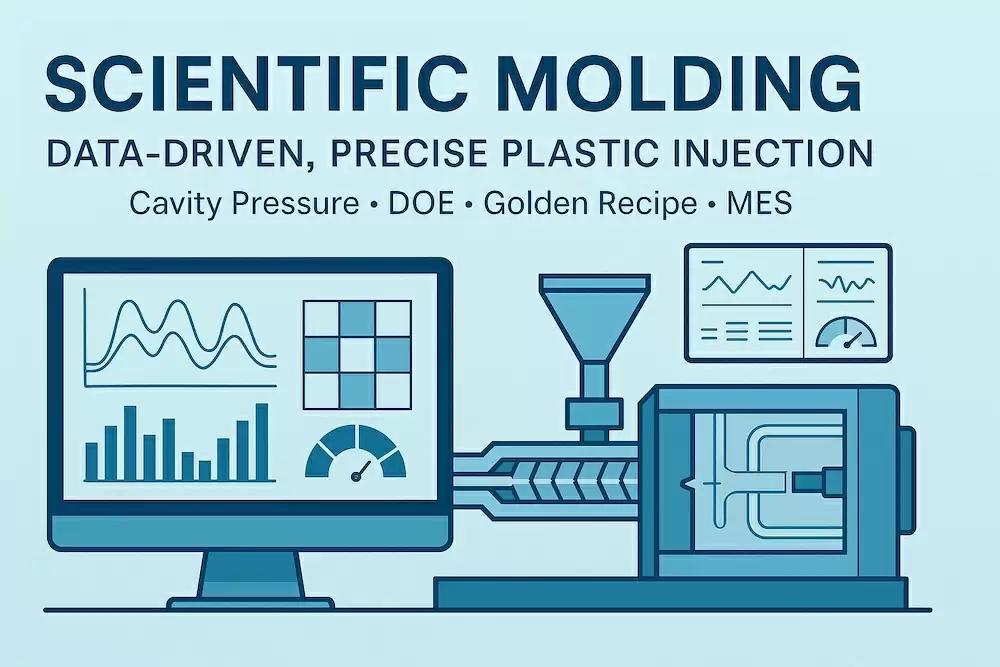Adopt Scientific Molding for Data-Driven, Precise Plastic Injection
Adopt Scientific Molding for Data-Driven, Precise Plastic Injection

Adopt Scientific Molding Principles for Data-Driven, Precise Plastic Injection
“Set-and-forget” molding is expensive. Scientific molding replaces guesswork with measured cavity pressure, DOE-mapped windows, and guarded recipes that deliver repeatable parts, faster cycles, and lower scrap—especially at tight CTQs and high volumes.
What Is Scientific Molding?
A disciplined method that:
-
Measures what matters (cavity pressure, melt/mold temps, cooling ΔT, screw position/velocity).
-
Builds a proven window via structured Design of Experiments (DOE).
-
Locks a golden recipe (V/P transfer, pack/hold profile, clamp force, cooling flow) with alarm limits in MES/SPC.
Goal: stable CpK at CTQs with minimum cycle time and cosmetic risk.
Core Principles (At a Glance)
| Principle | Why It Matters | Practical Action |
|---|---|---|
| Cavity Pressure Control | Precisely sets V/P transfer & pack; predicts dimensional drift | Install sensors in at least one cavity; transfer on pressure, not just screw position |
| Robust V/P Transfer | Prevents over/under-packing; stabilizes cosmetics & weight | Use cavity-pressure inflection; verify with weight ladder & dimensional response |
| Cooling Balance | Cooling dominates cycle & warp | Parallel circuits, ΔT ≤ 5 °C, Reynolds > 4,000, conformal inserts where hotspots persist |
| Gate & Runner Discipline | Shear, weld lines, vestige control | Choose fan/film for skins, valve/sequential for long flows; size lands properly |
| DOE-Mapped Window | Proof beats opinion | Vary fill speed, melt/mold temp, pack pressure/time, cooling; record cavity & part metrics |
| SPC + MES Guardrails | Catch drift before bad parts ship | Live OEE/CpK, cavity-pressure envelopes, auto hold-and-sort logic |
A Fast, Practical Scientific Molding Workflow
-
Instrument & Baseline
-
Add cavity pressure + thermocouples; verify dryer/throughput; check screw/check-ring health.
-
-
Short-Shot Study
-
Identify viscous vs. velocity-limited regions; confirm gate seal and V/P transfer candidates.
-
-
Weight Ladder & Gate Freeze
-
Increment pack/hold; plot part weight vs. time/pressure to locate freeze and pack-efficient zone.
-
-
DOE (Fill–Pack–Cool)
-
Factors: fill speed, melt/mold temps, pack pressure/time, cooling flow;
-
Responses: cavity peak/area, part weight, CTQ dimensions/warpage, cosmetics, cycle.
-
-
Golden Recipe + Alarm Limits
-
Lock fill profile, transfer by cavity pressure, pack profile, clamp, cooling flows; set ± limits and interlocks.
-
-
Validation & Handoff
-
FAIR, CMM/scan, GR&R on CTQs; save cavity signatures; train operators; push to MES.
-
Typical, Realistic Wins
| KPI | Before (Conventional) | After (Scientific) |
|---|---|---|
| Cycle (PP cap, 16-cav) | 8.8 s | 7.5–7.9 s |
| Scrap rate | 2.5% | ≤ 0.8–1.2% |
| Dimensional CpK @ CTQ | 1.33 | ≥ 1.67 |
| Color ΔE variance | 1.8–2.2 | ≤ 1.0–1.5 |
Actuals depend on resin, geometry, and tool health; results above are representative.
Design Rules That Enable Data-Driven Stability
-
Uniform walls; ribs at 40–60% of wall to prevent sink and speed cooling.
-
Draft: ≥1.0–1.5° textured; ≥0.5° polished; add more on deep ribs/cores.
-
Bosses: ID ≈ 60–70% OD; fillet bases; tie into walls with ribs.
-
Gates: avoid A-class surfaces; use fan/film for skins; sequential valves for long flow or weld relocation.
-
GF materials: align flow with load paths; gate to manage fiber orientation & warp.
-
Cooling: depth ≈ 1–1.5× channel Ø; pitch 2–3× Ø; parallel circuits with similar line lengths.
What to Measure (Minimum Viable Instrumentation)
-
Cavity pressure (at least one critical cavity + optional end-of-fill).
-
Melt & mold temperatures (nozzle & near-wall thermocouples).
-
Cooling ΔT per circuit (in/out) and flow (l/min).
-
Screw position/velocity & time stamps (fill, pack, recovery).
-
Part responses: weight, CTQs (CMM/scan), warpage, cosmetics (ΔE/gloss).
SPC & MES: Make the Data Work
-
Live envelopes for cavity-pressure curves (peak, area under curve, transfer point).
-
Auto containment: if envelope breach → hold bin + alert.
-
Dashboards: OEE, scrap by cause, CpK at CTQs, kWh/kg energy tracking.
-
APIs to your ERP/MES for genealogy and COA generation.
Troubleshooting by Signal (Cheatsheet)
| Symptom | Cavity-Pressure Signal | First Actions |
|---|---|---|
| Short shots | Low peak/area; early flattening | Raise melt/mold temp; increase fill speed; enlarge gate/vent |
| Sink/voids | Low pack plateau; early freeze | Extend/raise pack; shorten gate land; core bosses; boost cooling near mass |
| Warp | Cavity temp variance; cycle variation | Balance cooling; conformal inserts; adjust pack/sequence |
| Weld-line weakness | Low temp at knit; curve dip | Raise mold temp; fan gate; sequential valves |
| Blush/jetting | High shear spike at start | Increase gate area; slow initial fill; raise mold temp |
How We Implement Scientific Molding (TaiwanMoldMaker.com Network)
-
48-Hour DFM Pack: gating/cooling map, risk register, cycle & CPU model.
-
Sensor plan & installation: cavity pressure + thermocouples at CTQs.
-
DOE & Windowing: structured tests with clear acceptance metrics.
-
Golden-recipe lock-in: parameter interlocks, signature envelopes, alarm limits.
-
Metrology first: FAIR, CMM/blue-light, GR&R; ΔE/gloss for A-class.
-
MES dashboards: OEE, CpK, scrap, energy; ERP/MES API & genealogy.
-
Scale path: prototype → bridge → multi-cavity steel with the same guarded recipe.
RFQ Template (Copy/Paste)
Subject: RFQ – Scientific Molding Setup & Production
Attachments: STEP/IGES + 2D with CTQs & cosmetic map
-
Annual volume & first PO qty:
-
Resin & color (grade/MFR; GF/FR/UV/food-contact):
-
CTQs & tolerances (dimensional, flatness/warp, bond, peel/shear):
-
Cosmetic class & ΔE/gloss targets (SPI texture codes):
-
Sensor plan: (cavity pressure, near-wall TC—locations)
-
DOE scope: (factors/responses, acceptance criteria)
-
Inspection pack: (FAIR, CMM/scan, GR&R, capability, PPAP/IQ-OQ-PQ if needed)
-
Automation: (EOAT, inline mark/weld/leak, vision SPC)
-
Data & traceability: (MES access, APIs, genealogy)
-
Target dates (T0/T1/PPAP/SOP) & Incoterms:
Related Services & Quick Links
-
Custom Mold & Design Maker – DFM & sensor strategy
https://www.taiwanmoldmaker.com/product/custom-mold -
Mold Service – aluminum, hybrid, and full-steel tooling
https://www.taiwanmoldmaker.com/product/mold-service -
Injection Mold – materials & processes overview
https://www.taiwanmoldmaker.com/product/injection-mold -
Molding – automated cells with vision SPC & MES
https://www.taiwanmoldmaker.com/product/molding -
Customer Examples – snapshots and results
https://www.taiwanmoldmaker.com/product/customer-examples
Call to Action
Ready to replace trial-and-error with measured, repeatable control? Send your CAD and CTQs to get a 48-Hour Scientific Molding Plan—sensor layout, DOE matrix, golden-recipe targets, and a launch schedule.
Request an Instant Quote → https://www.taiwanmoldmaker.com/contact








